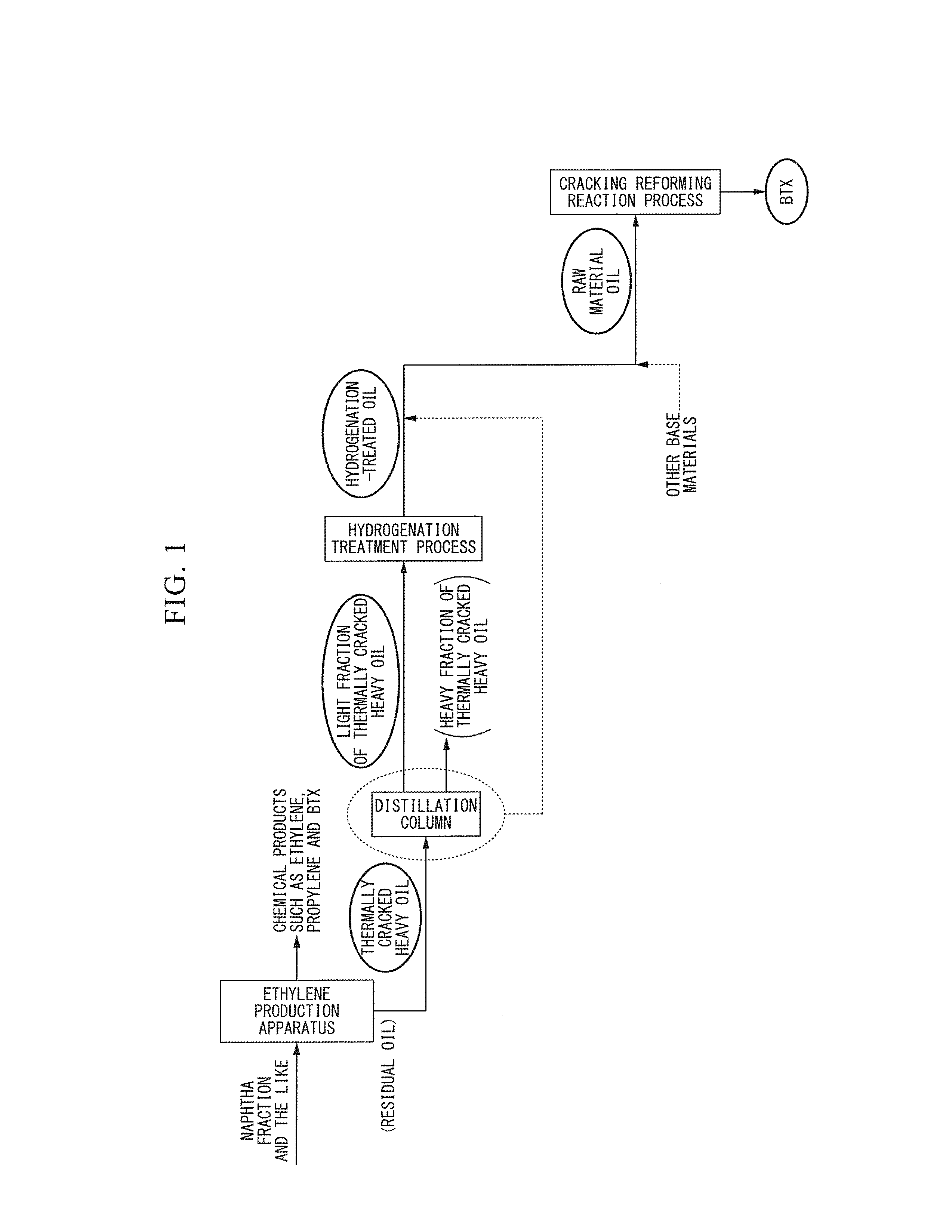Method for producing aromatic hydrocarbons
a technology of aromatic hydrocarbons and hydrocarbons, which is applied in the direction of hydrocarbon oil treatment products, metal/metal-oxide/metal-hydroxide catalysts, physical/chemical process catalysts, etc., can solve the problem of large hydrogen consumption, insufficient conversion of polycyclic aromatic components, and inability to always increase the yield of btx from polycyclic aromatic components, etc. problem, to achieve the effect of efficient production
- Summary
- Abstract
- Description
- Claims
- Application Information
AI Technical Summary
Benefits of technology
Problems solved by technology
Method used
Image
Examples
preparation example 1
For Catalyst for Monocyclic Aromatic Hydrocarbon Production
Preparation of Catalyst Containing Ga and Phosphorus-Supported Crystalline Aluminosilicate
[0144]A solution (A) containing sodium silicate (J sodium silicate No. 3, SiO2: 28 mass % to 30 mass %, Na: 9 mass % to 10 mass %, balance water, manufactured by Nippon Chemical Industrial Co., Ltd.): 1706.1 g and water: 2227.5 g, and a solution (B) containing Al2(SO4)3.14-18H2O (reagent grade, manufactured by Wako Pure Chemical Industries, Ltd.): 64.2 g, tetrapropylammonium bromide: 369.2 g, H2SO4 (97 mass %): 152.1 g, NaCl: 326.6 g and water: 2975.7 g were respectively prepared.
[0145]Subsequently, while the solution (A) was stirred at room temperature, the solution (B) was slowly added to the solution (A).
[0146]The mixture thus obtained was vigorously stirred for 15 minutes in a mixer, and the gel was crushed to obtain fine emulsion.
[0147]Subsequently, this mixture was placed in an autoclave made of stainless steel, and a crystallizat...
preparation example 2
For Catalyst for Monocyclic Aromatic Hydrocarbon Production
Preparation of Catalyst Containing Zn and Phosphorus-Supported Crystalline Aluminosilicate
[0153]A solution (A) containing sodium silicate (J sodium silicate No. 3, SiO2: 28 mass % to 30 mass %, Na: 9 mass % to 10 mass %, balance water, manufactured by Nippon Chemical Industrial Co., Ltd.): 1706.1 g and water: 2227.5 g, and a solution (B) containing Al2(SO4)3.14-18H2O (reagent grade, manufactured by Wako Pure Chemical Industries, Ltd.): 64.2 g, tetrapropylammonium bromide: 369.2 g, H2SO4 (97 mass %): 152.1 g, NaCl: 326.6 g and water: 2975.7 g were respectively prepared.
[0154]Subsequently, while the solution (A) was stirred at room temperature, the solution (B) was slowly added to the solution (A).
[0155]The mixture thus obtained was vigorously stirred for 15 minutes in a mixer, and the gel was crushed to obtain fine emulsion.
[0156]Subsequently, this mixture was placed in an autoclave made of stainless steel, and a crystallizat...
PUM
| Property | Measurement | Unit |
|---|---|---|
| Temperature | aaaaa | aaaaa |
| Percent by mass | aaaaa | aaaaa |
| Percent by mass | aaaaa | aaaaa |
Abstract
Description
Claims
Application Information
 Login to View More
Login to View More - R&D
- Intellectual Property
- Life Sciences
- Materials
- Tech Scout
- Unparalleled Data Quality
- Higher Quality Content
- 60% Fewer Hallucinations
Browse by: Latest US Patents, China's latest patents, Technical Efficacy Thesaurus, Application Domain, Technology Topic, Popular Technical Reports.
© 2025 PatSnap. All rights reserved.Legal|Privacy policy|Modern Slavery Act Transparency Statement|Sitemap|About US| Contact US: help@patsnap.com


